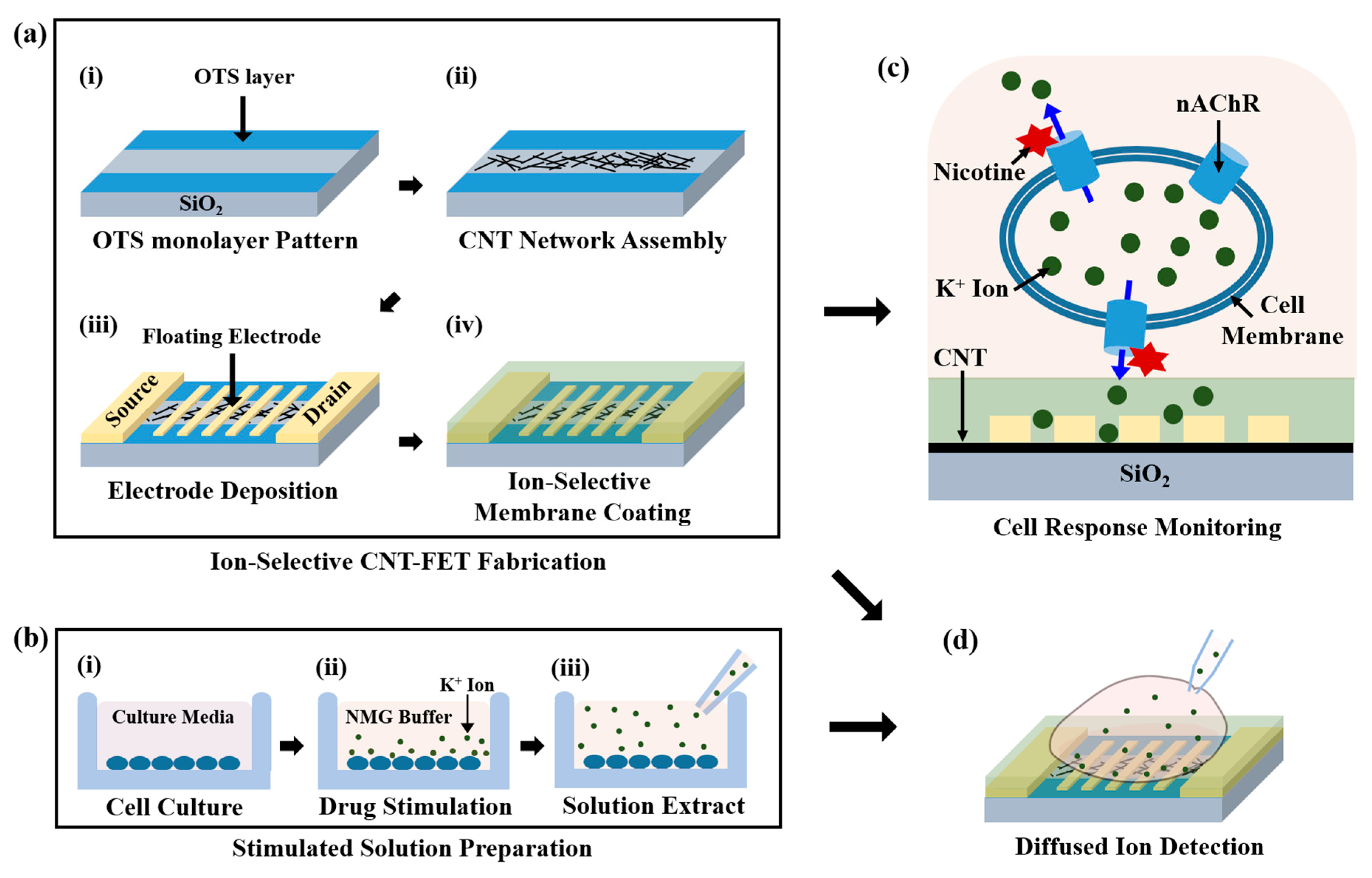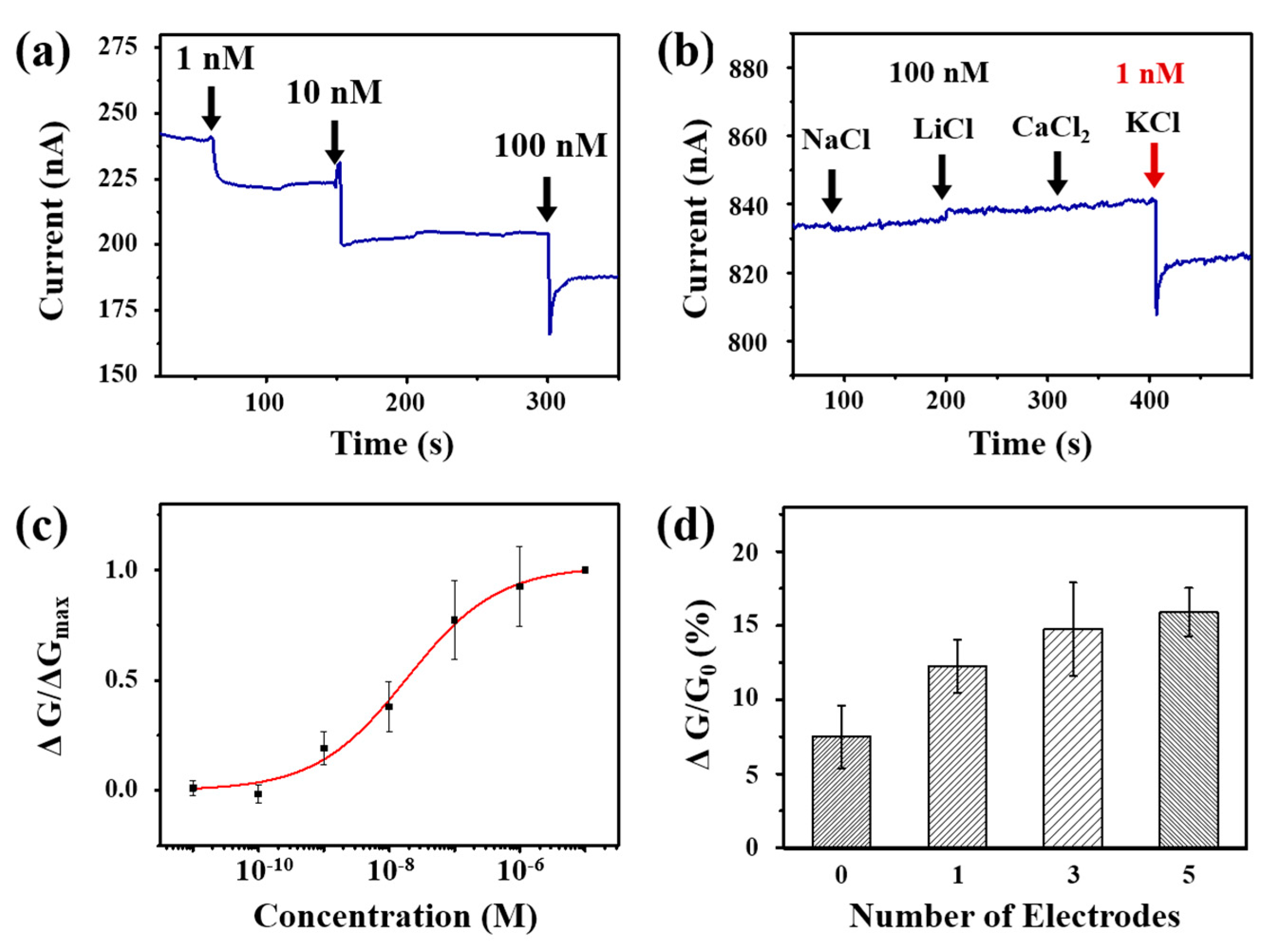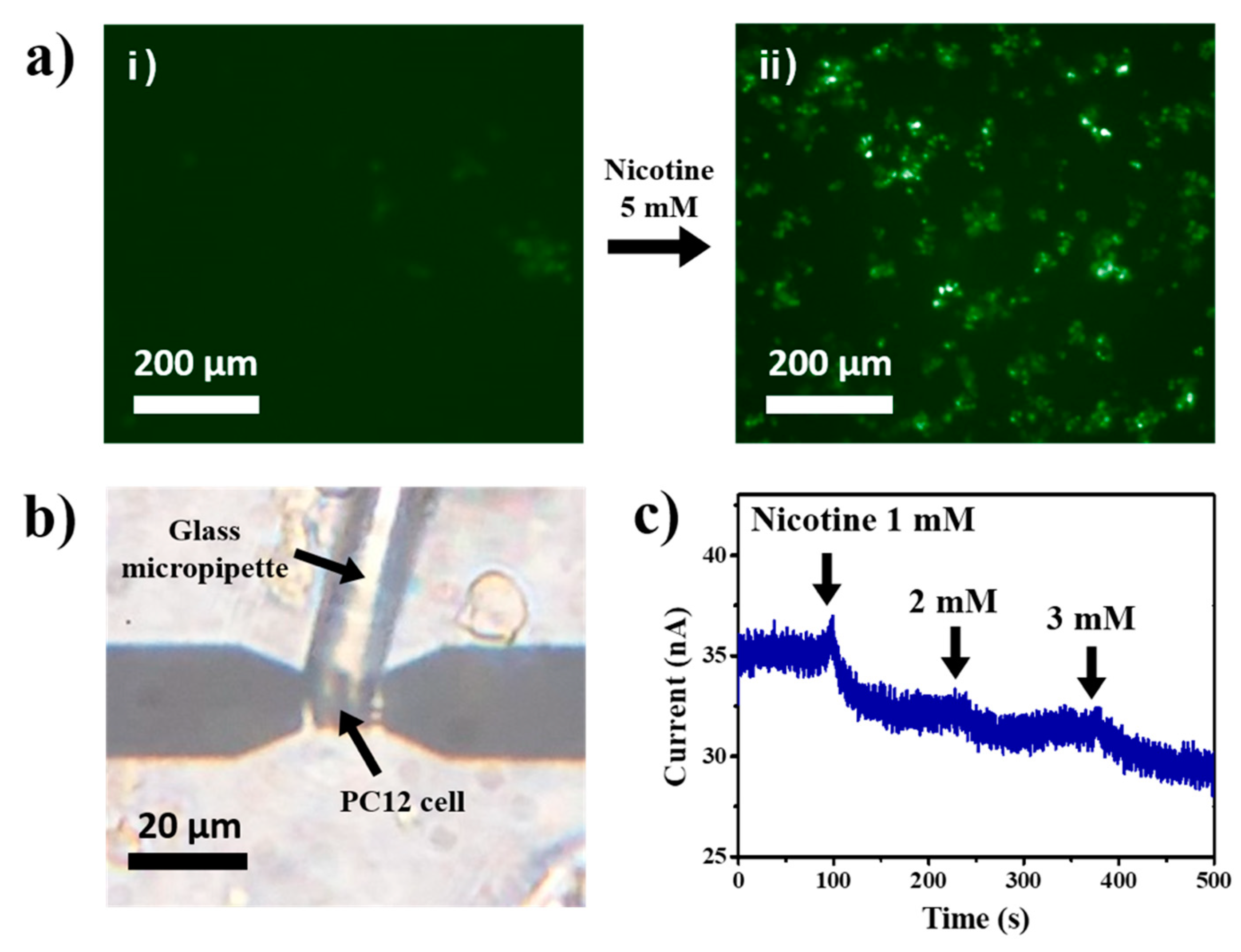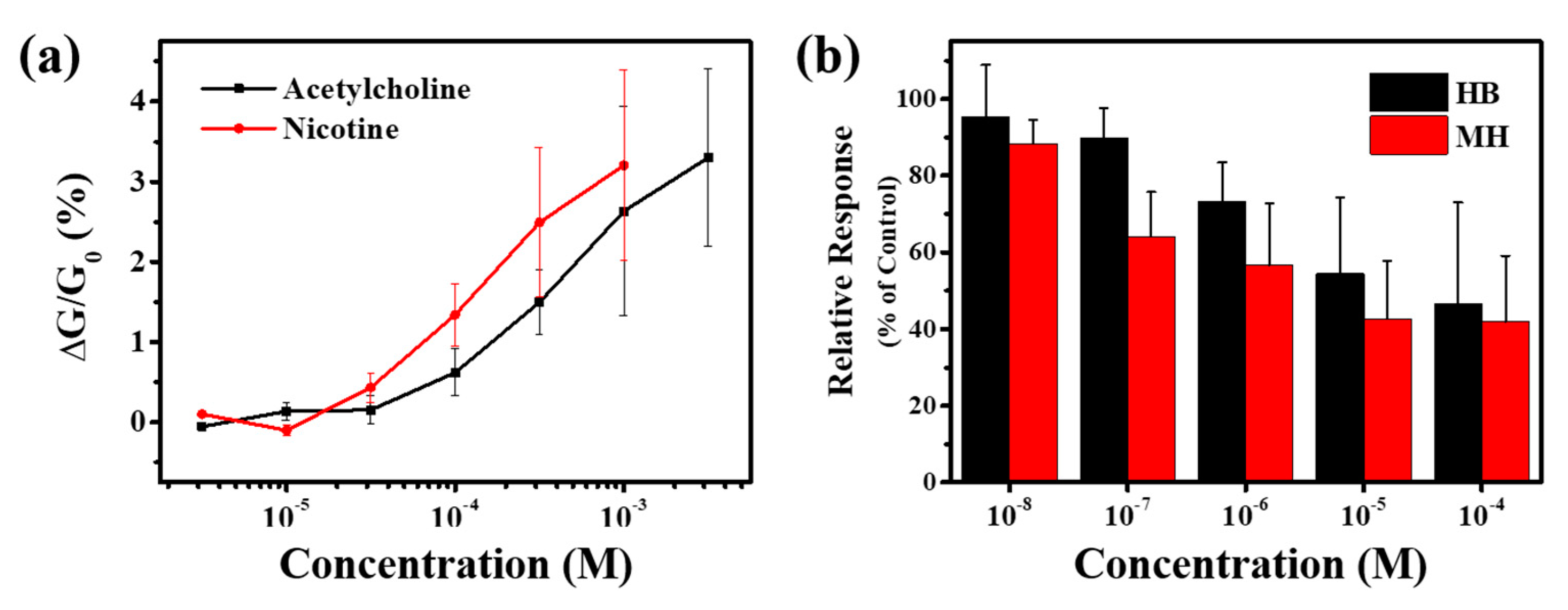Ion-Selective Carbon Nanotube Field-Effect Transistors for Monitoring Drug Effects on Nicotinic Acetylcholine Receptor Activation in Live Cells
Abstract
1. Introduction
2. Materials and Methods
2.1. Materials
2.2. CNT-FET Preparation
2.3. Preparation and Stimulation of PC12 Cells
2.4. Electrical Measurements of Multiple Cells
2.5. Statistical Analysis
2.6. Fluorescence Imaging of Stimulated Cells
3. Results and Discussion
3.1. Characteristics of an Ion-Selective CNT-FET Sensor
3.2. Detection of Potassium Ion by Using Ion Sensor
3.3. Activation of Ion Channel-Linked Receptor
3.4. Drug Effect Monitoring Using Ion-selective Sensors
4. Conclusions
Supplementary Materials
Author Contributions
Funding
Conflicts of Interest
References
- MacDermott, A.B.; Role, L.W.; Siegelbaum, S.A. Presynaptic ionotropic receptors and the control of transmitter release. Annu. Rev. Neurosci. 1999, 22, 443–485. [Google Scholar] [CrossRef] [PubMed]
- Shen, J.X.; Yakel, J.L. Nicotinic acetylcholine receptor-mediated calcium signaling in the nervous system. Acta. Pharmacol. Sin. 2009, 30, 673–680. [Google Scholar] [CrossRef] [PubMed]
- Hattori, M.; Gouaux, E. Molecular mechanism of ATP binding and ion channel activation in P2X receptors. Nature 2012, 485, 207–212. [Google Scholar] [CrossRef] [PubMed]
- Dunlop, J.; Bowlby, M.; Peri, R.; Vasilyev, D.; Arias, R. High-throughput electrophysiology: an emerging paradigm for ion-channel screening and physiology. Nat. Rev. Drug Discovery 2008, 7, 358–368. [Google Scholar] [CrossRef]
- Xu, Y.; Yan, J.; Zhou, P.; Li, J.; Gao, H.; Xia, Y.; Wang, Q. Neurotransmitter receptors and cognitive dysfunction in Alzheimer’s disease and Parkinson’s disease. Prog. Neurobiol. 2012, 97, 1–13. [Google Scholar] [CrossRef]
- Weiland, S.; Bertrand, D.; Leonard, S. Neuronal nicotinic acetylcholine receptors: from the gene to the disease. Behav. Brain Res. 2000, 113, 43–56. [Google Scholar] [CrossRef]
- Parikh, V.; Kutlu, M.G.; Gould, T.J. nAChR dysfunction as a common substrate for schizophrenia and comorbid nicotine addiction: Current trends and perspectives. Schizophrenia Res. 2016, 171, 1–15. [Google Scholar] [CrossRef]
- Bertrand, D.; Picard, F.; Le Hellard, S.; Weiland, S.; Favre, I.; Phillips, H.; Bertrand, S.; Berkovic, S.; Malafosse, A.; Mulley, J. How mutations in the nAChRs can cause ADNFLE epilepsy. Epilepsia 2002, 43, 112–122. [Google Scholar] [CrossRef]
- Perez-Lloret, S.; Barrantes, F.J. Deficits in cholinergic neurotransmission and their clinical correlates in Parkinson’s disease. Nat. Partner J. Parkinson’s Dis. 2016, 2, 1–12. [Google Scholar] [CrossRef]
- Paz, M.L.; Barrantes, F.J. Autoimmune Attack of the Neuromuscular Junction in Myasthenia Gravis: Nicotinic Acetylcholine Receptors and Other Targets. ACS. Chem. Neurosci. 2019, 10, 2186–2194. [Google Scholar] [CrossRef]
- Xiao, Y.; Meyer, E.L.; Thompson, J.M.; Surin, A.; Wroblewski, J.; Kellar, K.J. Rat α3/β4 subtype of neuronal nicotinic acetylcholine receptor stably expressed in a transfected cell line: pharmacology of ligand binding and function. Mol. Pharmacol. 1998, 54, 322–333. [Google Scholar] [CrossRef] [PubMed]
- Rogers, K.R.; Eldefrawi, M.E.; Menking, D.E.; Thompson, R.G.; Valdes, J.J. Pharmacological Specificity of a Nicotinic Acetylcholine-Receptor Optical Sensor. Biosens. Bioelectron. 1991, 6, 507–516. [Google Scholar] [CrossRef]
- Kröger, D.; Hucho, F.; Vogel, H. Ligand binding to nicotinic acetylcholine receptor investigated by surface plasmon resonance. Anal. Chem. 1999, 71, 3157–3165. [Google Scholar] [CrossRef]
- Lukas, R.J.; Cullen, M.J. An isotopic rubidium ion efflux assay for the functional characterization of nicotinic acetylcholine receptors on clonal cell lines. Anal. Biochem. 1988, 175, 212–218. [Google Scholar] [CrossRef]
- Buisson, B.; Gopalakrishnan, M.; Arneric, S.P.; Sullivan, J.P.; Bertrand, D. Human α4β2 neuronal nicotinic acetylcholine receptor in HEK 293 cells: A patch-clamp study. J. Neurosci. 1996, 16, 7880–7891. [Google Scholar] [CrossRef]
- Suk, H.-J.; Boyden, E.S.; van Welie, I. Advances in the automation of whole-cell patch clamp technology. J. Neurosci. Methods 2019, 108357. [Google Scholar] [CrossRef]
- Danielson, U.H. Fragment library screening and lead characterization using SPR biosensors. Curr. Med. Chem. 2009, 9, 1725–1735. [Google Scholar] [CrossRef]
- Xu, S.; Zhang, C.; Jiang, S.; Hu, G.; Li, X.; Zou, Y.; Liu, H.; Li, J.; Li, Z.; Wang, X. Graphene foam field-effect transistor for ultra-sensitive label-free detection of ATP. Sens. Actuators B Chem. 2019, 284, 125–133. [Google Scholar] [CrossRef]
- Haslam, C.; Damiati, S.; Whitley, T.; Davey, P.; Ifeachor, E.; Awan, S.A. Label-free sensors based on graphene field-effect transistors for the detection of human chorionic gonadotropin cancer risk biomarker. Diagnostics 2018, 8, 5. [Google Scholar] [CrossRef]
- Seshadri, P.; Manoli, K.; Schneiderhan-Marra, N.; Anthes, U.; Wierzchowiec, P.; Bonrad, K.; Di Franco, C.; Torsi, L. Low-picomolar, label-free procalcitonin analytical detection with an electrolyte-gated organic field-effect transistor based electronic immunosensor. Biosens. Bioelectron. 2018, 104, 113–119. [Google Scholar] [CrossRef]
- Pham Ba, V.A.; Han, Y.M.; Cho, Y.; Kim, T.; Lee, B.Y.; Kim, J.S.; Hong, S. Modified floating electrode-based sensors for the quantitative monitoring of drug effects on cytokine levels related with inflammatory bowel diseases. ACS Appl. Mater. Interfaces 2018, 10, 17100–17106. [Google Scholar] [CrossRef]
- Pham Ba, V.A.; Cho, D.-g.; Hong, S. Nafion-Radical Hybrid Films on Carbon Nanotube Transistors for Monitoring Antipsychotic Drug Effects on Stimulated Dopamine Release. ACS Appl. Mater. Interfaces 2019, 11, 9716–9723. [Google Scholar] [CrossRef]
- Ta, V.-T.; Park, J.; Park, E.J.; Hong, S. Reusable floating-electrode sensor for the quantitative electrophysiological monitoring of a nonadherent cell. ACS Nano 2014, 8, 2206–2213. [Google Scholar] [CrossRef] [PubMed]
- Majd, S.M.; Salimi, A.; Ghasemi, F. An ultrasensitive detection of miRNA-155 in breast cancer via direct hybridization assay using two-dimensional molybdenum disulfide field-effect transistor biosensor. Biosens. Bioelectron. 2018, 105, 6–13. [Google Scholar] [CrossRef] [PubMed]
- Vernick, S.; Trocchia, S.M.; Warren, S.B.; Young, E.F.; Bouilly, D.; Gonzalez, R.L.; Nuckolls, C.; Shepard, K.L. Electrostatic melting in a single-molecule field-effect transistor with applications in genomic identification. Nat. Commun. 2017, 8, 1–9. [Google Scholar] [CrossRef] [PubMed]
- Silva, G.O.; Michael, Z.P.; Bian, L.; Shurin, G.V.; Mulato, M.; Shurin, M.R.; Star, A. Nanoelectronic Discrimination of Nonmalignant and Malignant Cells Using Nanotube Field-Effect Transistors. ACS Sens. 2017, 2, 1128–1132. [Google Scholar] [CrossRef]
- Scuratti, F.; Bonacchini, G.E.; Bossio, C.; Salazar-Rios, J.M.; Talsma, W.; Loi, M.A.; Antognazza, M.R.; Caironi, M. Real-Time Monitoring of Cellular Cultures with Electrolyte-Gated Carbon Nanotube Transistors. ACS Appl. Mater. Interfaces 2019, 11, 37966–37972. [Google Scholar] [CrossRef]
- Xu, X.; Clément, P.; Eklöf-Österberg, J.; Kelley-Loughnane, N.; Moth-Poulsen, K.; Chávez, J.L.; Palma, M. Reconfigurable carbon nanotube multiplexed sensing devices. Nano Lett. 2018, 18, 4130–4135. [Google Scholar] [CrossRef]
- Kang, H.; Kim, J.-Y.; Choi, Y.-K.; Nam, Y. Feasibility study of extended-gate-type silicon nanowire field-effect transistors for neural recording. Sensors 2017, 17, 705. [Google Scholar] [CrossRef]
- Sakata, T.; Matsuse, Y. In situ electrical monitoring of cancer cells invading vascular endothelial cells with semiconductor-based biosensor. Genes Cells 2017, 22, 203–209. [Google Scholar] [CrossRef]
- Duan, X.; Gao, R.; Xie, P.; Cohen-Karni, T.; Qing, Q.; Choe, H.S.; Tian, B.; Jiang, X.; Lieber, C.M. Intracellular recordings of action potentials by an extracellular nanoscale field-effect transistor. Nat. Nanotechnol. 2011, 7, 174–179. [Google Scholar] [CrossRef] [PubMed]
- Sakata, T.; Sugimoto, H.; Saito, A. Live monitoring of microenvironmental pH based on extracellular acidosis around cancer cells with cell-coupled gate ion-sensitive field-effect transistor. Anal. Chem. 2018, 90, 12731–12736. [Google Scholar] [CrossRef] [PubMed]
- Veliev, F.; Cresti, A.; Kalita, D.; Bourrier, A.; Belloir, T.; Briançon-Marjollet, A.; Albrieux, M.; Roche, S.; Bouchiat, V.; Delacour, C. Sensing ion channel in neuron networks with graphene field effect transistors. 2D Mater. 2018, 5, 045020. [Google Scholar] [CrossRef]
- Wang, Y.; Zhang, S.; Xu, T.; Zhang, T.; Mo, Y.; Liu, J.; Yan, L.; Xing, F. Ultra-sensitive and ultra-fast detection of whole unlabeled living cancer cell responses to paclitaxel with a graphene-based biosensor. Sens. Actuators B Chem. 2018, 263, 417–425. [Google Scholar] [CrossRef]
- Kim, B.; Lee, J.; Namgung, S.; Kim, J.; Park, J.Y.; Lee, M.-S.; Hong, S. DNA sensors based on CNT-FET with floating electrodes. Sens. Actuators B Chem. 2012, 169, 182–187. [Google Scholar] [CrossRef]
- Michalska, A.J.; Appaih-Kusi, C.; Heng, L.Y.; Walkiewicz, S.; Hall, E.A. An experimental study of membrane materials and inner contacting layers for ion-selective K+ electrodes with a stable response and good dynamic range. Anal. Chem. 2004, 76, 2031–2039. [Google Scholar] [CrossRef]
- Lee, M.; Lee, J.; Kim, T.H.; Lee, H.; Lee, B.Y.; Park, J.; Jhon, Y.M.; Seong, M.J.; Hong, S. 100 nm scale low-noise sensors based on aligned carbon nanotube networks: overcoming the fundamental limitation of network-based sensors. Nanotechnology 2010, 21, 055504. [Google Scholar] [CrossRef]
- Lee, M.; Im, J.; Lee, B.Y.; Myung, S.; Kang, J.; Huang, L.; Kwon, Y.K.; Hong, S. Linker-free directed assembly of high-performance integrated devices based on nanotubes and nanowires. Nat. Nanotechnol. 2006, 1, 66–71. [Google Scholar] [CrossRef]
- Cid, C.C.; Riu, J.; Maroto, A.; Rius, F.X. Ion-sensitive field effect transistors using carbon nanotubes as the transducing layer. Analyst 2008, 133, 1001–1004. [Google Scholar] [CrossRef]
- Michalska, A.; Maksymiuk, K. All-plastic, disposable, low detection limit ion-selective electrodes. Anal. Chim. Acta 2004, 523, 97–105. [Google Scholar] [CrossRef]
- Ritjareonwattu, S.; Yun, Y.; Pearson, C.; Petty, M.C. An Ion Sensitive Organic Field-Effect Transistor Incorporating the Ionophore Valinomycin. IEEE Sens. J. 2012, 12, 1181–1186. [Google Scholar] [CrossRef]
- Kawakami, S.; Akiyama, T.; Ujihira, Y. Potassium Ion-Sensitive Field-Effect Transistors Using Valinomycin Doped Photoresist Membrane. Fresen Z Anal. Chem. 1984, 318, 349–351. [Google Scholar] [CrossRef]
- Maehashi, K.; Sofue, Y.; Okamoto, S.; Ohno, Y.; Inoue, K.; Matsumoto, K. Selective ion sensors based on ionophore-modified graphene field-effect transistors. Sens. Actuators B Chem. 2013, 187, 45–49. [Google Scholar] [CrossRef]
- Rose, M.C.; Henkens, R.W. Stability of Sodium and Potassium Complexes of Valinomycin. Biochim. Biophys. Acta 1974, 372, 426–435. [Google Scholar] [CrossRef]
- Jin, H.J.; An, J.M.; Park, J.; Moon, S.J.; Hong, S. “Chemical-pain sensor” based on nanovesicle–carbon nanotube hybrid structures. Biosens. Bioelectron. 2013, 49, 86–91. [Google Scholar] [CrossRef] [PubMed]
- Kim, T.H.; Lee, B.Y.; Jaworski, J.; Yokoyama, K.; Chung, W.-J.; Wang, E.; Hong, S.; Majumdar, A.; Lee, S.-W. Selective and sensitive TNT sensors using biomimetic polydiacetylene-coated CNT-FETs. ACS Nano 2011, 5, 2824–2830. [Google Scholar] [CrossRef] [PubMed]
- Qin, Y.; Mi, Y.M.; Bakker, E. Determination of complex formation constants of 18 neutral alkali and alkaline earth metal ionophores in poly(vinyl chloride) sensing membranes plasticized with bis(2-ethylhexyl)sebacate and o-nitrophenyloctylether. Anal. Chim. Acta 2000, 421, 207–220. [Google Scholar] [CrossRef]
- Telting-Diaz, M.; Bakker, E. Effect of lipophilic ion-exchanger leaching on the detection limit of carrier-based ion-selective electrodes. Anal. Chem. 2001, 73, 5582–5589. [Google Scholar] [CrossRef]
- Qin, W.; Zwickl, T.; Pretsch, E. Improved detection limits and unbiased selectivity coefficients obtained by using ion-exchange resins in the inner reference solution of ion selective polymeric membrane electrodes. Anal. Chem. 2000, 72, 3236–3240. [Google Scholar] [CrossRef]
- Heller, I.; Janssens, A.M.; Männik, J.; Minot, E.D.; Lemay, S.G.; Dekker, C. Identifying the mechanism of biosensing with carbon nanotube transistors. Nano Lett. 2008, 8, 591–595. [Google Scholar] [CrossRef]
- Byon, H.R.; Choi, H.C. Network single-walled carbon nanotube-field effect transistors (SWNT-FETs) with increased Schottky contact area for highly sensitive biosensor applications. J. Am. Chem. Soc. 2006, 128, 2188–2189. [Google Scholar] [CrossRef]
- Sands, S.; Barish, M. Neuronal nicotinic acetylcholine receptor currents in phaeochromocytoma (PC12) cells: Dual mechanisms of rectification. J. Physiol. 1992, 447, 467–487. [Google Scholar] [CrossRef]
- Lukas, R.J. Pharmacological distinctions between functional nicotinic acetylcholine receptors on the PC12 rat pheochromocytoma and the TE671 human medulloblastoma. J. Pharmacol. Exp. Ther. 1989, 251, 175–182. [Google Scholar] [PubMed]
- Ifune, C.K.; Steinbach, J.H. Regulation of Sodium Currents and Acetylcholine Responses in PC12 Cells. Brain Res. 1990, 506, 243–248. [Google Scholar] [CrossRef]
- Sands, S.B.; Barish, M.E. Calcium Permeability of Neuronal Nicotinic Acetylcholine-Receptor Channels in Pc12 Cells. Brain Res. 1991, 560, 38–42. [Google Scholar] [CrossRef]
- Dani, J.A.; Eisenman, G. Monovalent and divalent cation permeation in acetylcholine receptor channels. Ion transport related to structure. J. Gen. Physiol. 1987, 89, 959–983. [Google Scholar] [CrossRef] [PubMed]
- Court, J.; Perry, E.; Spurden, D.; Lloyd, S.; Gillespie, J.; Whiting, P.; Barlow, R. Comparison of the binding of nicotinic agonists to receptors from human and rat cerebral cortex and from chick brain (α4β2) transfected into mouse fibroblasts with ion channel activity. Brain Res. 1994, 667, 118–122. [Google Scholar] [CrossRef]
- Hansen, S.B.; Taylor, P. Galanthamine and non-competitive inhibitor binding to ACh-binding protein: evidence for a binding site on non-alpha-subunit interfaces of heteromeric neuronal nicotinic receptors. J. Mol. Biol. 2007, 369, 895–901. [Google Scholar] [CrossRef]
- Shimizu, T.; Tanaka, K.; Hasegawa, T.; Yokotani, K. Brain α4β2 nicotinic acetylcholine receptors are involved in the secretion of noradrenaline and adrenaline from adrenal medulla in rats. Eur. J. Pharmacol. 2011, 654, 241–248. [Google Scholar] [CrossRef]
- Armitage, A. Effects of nicotine and tobacco smoke on blood pressure and release of catechol amines from the adrenal glands. Br. J. Pharmacol. Chemother. 1965, 25, 515. [Google Scholar] [CrossRef]
- Virdis, A.; Giannarelli, C.; Fritsch Neves, M.; Taddei, S.; Ghiadoni, L. Cigarette smoking and hypertension. Curr. Pharm. Des. 2010, 16, 2518–2525. [Google Scholar] [CrossRef] [PubMed]
- Kanda, Y.; Watanabe, Y. Nicotine-induced vascular endothelial growth factor release via the EGFR-ERK pathway in rat vascular smooth muscle cells. Life Sci. 2007, 80, 1409–1414. [Google Scholar] [CrossRef] [PubMed]
- Yang, C.; Li, Z.; Yan, S.; He, Y.; Dai, R.; Leung, G.P.h.; Pan, S.; Yang, J.; Yan, R.; Du, G. Role of the nicotinic acetylcholine receptor α3 subtype in vascular inflammation. Br. J. Pharmacol. 2016, 173, 3235–3247. [Google Scholar] [CrossRef] [PubMed]
- Li, P.; Gong, J.X.; Sun, W.; Zhou, B.; Kong, X.Q. Hexamethonium attenuates sympathetic activity and blood pressure in spontaneously hypertensive rats. Mol. Med. Rep. 2015, 12, 7116–7122. [Google Scholar] [CrossRef] [PubMed]
- Schneckloth, R.E.; Corcoran, A.C.; Dustan, H.P.; Page, I.H. Mecamylamine in Treatment of Hypertensive Disease: Observations on an Unusual Neuromuscular Complication. J. Am. Med. Assoc. 1956, 162, 868–875. [Google Scholar] [CrossRef]
- Bacher, I.; Wu, B.; Shytle, D.R.; George, T.P. Mecamylamine–a nicotinic acetylcholine receptor antagonist with potential for the treatment of neuropsychiatric disorders. Expert Opin. Pharmacother. 2009, 10, 2709–2721. [Google Scholar] [CrossRef]
- Rose, J.E.; Behm, F.M.; Westman, E.C. Nicotine–mecamylamine treatment for smoking cessation: The role of pre-cessation therapy. Exp. Clin. Psychopharmacol. 1998, 6, 331. [Google Scholar] [CrossRef]
- Campbell, A.; Robertson, E. Treatment of severe hypertension with hexamethonium bromide. Br. Med. J. 1950, 2, 804. [Google Scholar] [CrossRef] [PubMed]
- Holladay, M.W.; Dart, M.J.; Lynch, J.K. Neuronal nicotinic acetylcholine receptors as targets for drug discovery. J. Med. Chem. 1997, 40, 4169–4194. [Google Scholar] [CrossRef]
- Nooney, J.M.; Peters, J.A.; Lambert, J.J. A Patch Clamp Study of the Nicotinic Acetylcholine-Receptor of Bovine Adrenomedullary Chromaffin Cells in Culture. J. Physiol-London 1992, 455, 503–527. [Google Scholar] [CrossRef]
- Ba, V.A.P.; Cho, D.-g.; Kim, D.; Yoo, H.; Ta, V.-T.; Hong, S. Quantitative electrophysiological monitoring of anti–histamine drug effects on live cells via reusable sensor platforms. Biosens. Bioelectron. 2017, 94, 707–713. [Google Scholar]
- Lukas, R.J. Nicotinic acetylcholine receptor diversity: agonist binding and functional potency. In Progress in Brain Research; Elsevier: Phoenix, AZ, USA, 1989; Volume 79, pp. 117–127. [Google Scholar]
- Marks, M.J.; Farnham, D.A.; Grady, S.R.; Collins, A.C. Nicotinic Receptor Function Determined by Stimulation of Rubidium Efflux from Mouse-Brain Synaptosomes. J. Pharmacol. Exp. Ther. 1993, 264, 542–552. [Google Scholar] [PubMed]





© 2020 by the authors. Licensee MDPI, Basel, Switzerland. This article is an open access article distributed under the terms and conditions of the Creative Commons Attribution (CC BY) license (http://creativecommons.org/licenses/by/4.0/).
Share and Cite
Cho, Y.; Pham Ba, V.A.; Jeong, J.-Y.; Choi, Y.; Hong, S. Ion-Selective Carbon Nanotube Field-Effect Transistors for Monitoring Drug Effects on Nicotinic Acetylcholine Receptor Activation in Live Cells. Sensors 2020, 20, 3680. https://doi.org/10.3390/s20133680
Cho Y, Pham Ba VA, Jeong J-Y, Choi Y, Hong S. Ion-Selective Carbon Nanotube Field-Effect Transistors for Monitoring Drug Effects on Nicotinic Acetylcholine Receptor Activation in Live Cells. Sensors. 2020; 20(13):3680. https://doi.org/10.3390/s20133680
Chicago/Turabian StyleCho, Youngtak, Viet Anh Pham Ba, Jin-Young Jeong, Yoonji Choi, and Seunghun Hong. 2020. "Ion-Selective Carbon Nanotube Field-Effect Transistors for Monitoring Drug Effects on Nicotinic Acetylcholine Receptor Activation in Live Cells" Sensors 20, no. 13: 3680. https://doi.org/10.3390/s20133680
APA StyleCho, Y., Pham Ba, V. A., Jeong, J.-Y., Choi, Y., & Hong, S. (2020). Ion-Selective Carbon Nanotube Field-Effect Transistors for Monitoring Drug Effects on Nicotinic Acetylcholine Receptor Activation in Live Cells. Sensors, 20(13), 3680. https://doi.org/10.3390/s20133680




